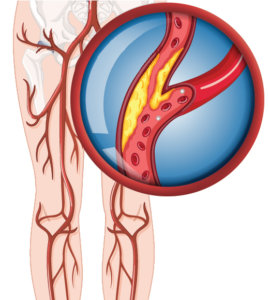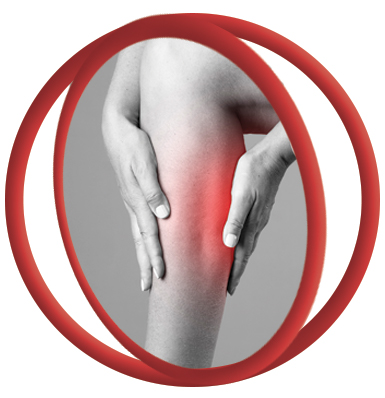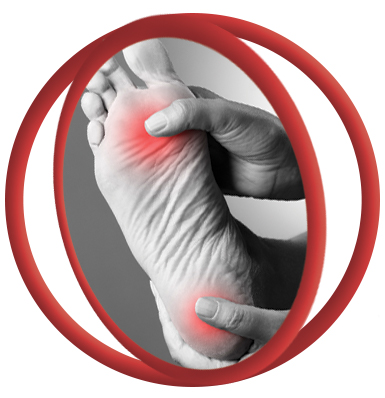Peripheral Arterial Disease
What is peripheral arterial disease (PAD)?
PAD is a common circulation problem in which the arteries that carry blood to the legs or arms become narrowed or clogged. This interferes with the normal flow of blood, sometimes causing pain, but often causing no symptoms at all. The most common cause of PAD is atherosclerosis, often called “hardening of the arteries.” Atherosclerosis is a gradual process in which cholesterol and scar tissue build up, forming a substance called “plaque” that clogs the blood vessels. In some cases, PAD may be caused by blood clots that lodge in the arteries and restrict blood flow. Left untreated, this insufficient blood flow will lead to limb amputation in some patients.

In atherosclerosis, the blood flow channel narrows from the buildup of plaque, preventing blood from passing through as needed, restricting oxygen and other nutrients from getting to normal tissue. The arteries also become less elastic and are less able to react to tissue demands for changes in blood flow. Many of the risk factors-high cholesterol, high blood pressure, smoking and diabetes-may also damage the blood vessel wall, making the blood vessel prone to diffuse plaque deposits.
Symptoms

- The most common symptom of PAD is called claudication, which is leg pain that occurs when walking or exercising and disappears when the person stops the activity.
- PAD is a disease of the arteries that affects 10 million Americans.

- Many people simply live with their pain, assuming it is a normal part of aging, rather than reporting it to their doctor.
- Other symptoms of PAD include numbness and tingling in the lower legs and feet, coldness in the lower legs and feet, and ulcers or sores on the legs or feet that don’t heal.
- PAD can happen to anyone, regardless of age, but it is most common in men and women over age 50. It affects 12-20 percent of Americans age 65 and older.
Risk Factors
- High cholesterol
- High blood pressure
- Smoking
- Diabetes
Diagnosis
The most common test for PAD is the ankle-brachial index (ABI), a painless exam in which ultrasound is used to measure the ratio of blood pressure in the feet and arms. Based on the results of your ABI, as well as your symptoms and risk factor for PAD, the physician can decide if further tests are needed. PAD also can be diagnosed noninvasively with an imaging technique called magnetic resonance angiography (MRA) or with computed tomography (CT) angiography.
Treatment
Lifestyle Changes
Often PAD can be treated with lifestyle changes. Smoking cessation and a structured exercise program are often all that is needed to alleviate symptoms and prevent further progression of the disease.
Treatment for PAD (Peripheral Arterial Disease) relies mainly on healthy lifestyle changes and taking care to manage high blood pressure and cholesterol. You may need medicines to ease symptoms or to manage other health problems. In some cases, you may need surgery or a procedure called angioplasty.
When you have PAD, you have a high risk of having a heart attack or stroke. Making healthy changes can help reduce this risk.
- If you smoke, quit. It’s one of the most important things you can do. If you need help, talk to your doctor about programs and medicines that can help you stop.
- Eat healthy foods.
- Follow an exercise program.
- Manage your cholesterol and blood pressure if they are high. You may need medicines to help you do this.
- If you have diabetes, keep your blood sugar in a target range.
Additional Treatment Options
If you would like to schedule an appointment at Preferred Vascular Group to have a consult with a Board-Certified physician or would like to have one of our highly trained care providers reach out to you, please click on a button below:
